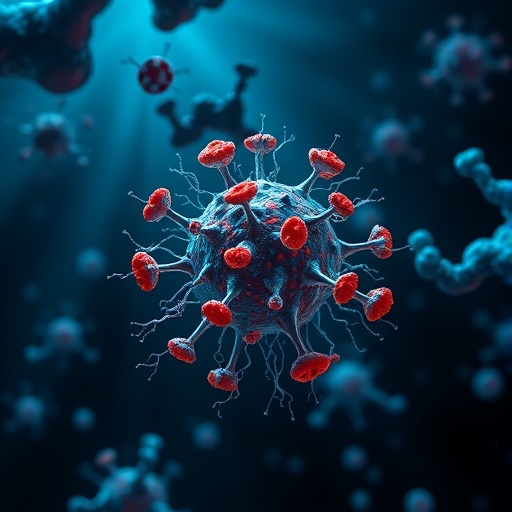In a groundbreaking study published on November 5, 2025, in npj Precision Oncology, researchers from Sanford Burnham Prebys Medical Discovery Institute and their collaborators have unveiled DeepTarget, a revolutionary computational tool designed to predict the anti-cancer mechanisms of small molecule drugs. This innovation challenges the traditional dogma of one drug-one target, shedding light on the complex and malleable nature of drug-target interactions in varying cellular contexts. By integrating large-scale genetic and pharmacological data, DeepTarget offers an unprecedented lens through which to view and repurpose existing medicines, potentially transforming the landscape of cancer treatment.
The foundation of DeepTarget lies in its principle that the genetic deletion of a drug’s protein target via CRISPR-Cas9 can mimic the inhibitory effects of the drug itself. Unlike conventional approaches that predominantly rely on the chemical structure and predicted binding affinity between drugs and their targets, DeepTarget leverages an extensive dataset derived from genetic and drug screening experiments encompassing 1450 drugs across 371 diverse cancer cell lines sourced from the Dependency Map Consortium. This rich dataset captures the multifaceted cellular responses to drug perturbations, enabling DeepTarget to infer mechanistic insights not readily apparent from structural data alone.
Sanju Sinha, PhD, the primary architect behind DeepTarget, emphasizes the paradigm shift this tool represents in understanding small molecule drugs. Historically, pharmaceutical research has viewed these compounds through a narrow prism, assigning them a single primary target and relegating other effects as undesirable side effects. This tunnel vision obscured the broader reality that small molecules, often synthetic and not evolved for specific biological functions, exhibit context-dependent targeting profiles. DeepTarget embraces this complexity, revealing that drugs can engage multiple targets with varying affinities and effects depending on the cell type and disease state, thus broadening therapeutic opportunities.
Benchmarking DeepTarget’s performance against established forefront computational methods such as RoseTTAFold All-Atom and Chai-1 yielded remarkable results. In seven out of eight comparative tests, DeepTarget not only matched but outperformed these models in accurately predicting primary drug targets within cancer cells. These findings underscore the advantage of integrating genetic perturbation data with pharmacological profiles, transcending the limitations of structural modeling that traditionally guides drug-target interaction predictions.
More compellingly, DeepTarget exhibits the ability to delineate preferential activity of drugs toward wild-type versus mutant forms of target proteins—an essential consideration in oncology, where genetic mutations heavily influence therapeutic outcomes. Furthermore, the tool adeptly identifies secondary drug targets, a feature of immense clinical relevance given that many FDA-approved and investigational cancer drugs exert their effects through polypharmacology. This multi-target engagement can be harnessed positively for drug repurposing and combination therapy design, viewing off-target interactions as strategic leverage points rather than liabilities.
The validation of DeepTarget’s predictions extended beyond computational analyses, incorporating experimental case studies to empirically confirm the tool’s accuracy. Notably, investigation into Ibrutinib, an established BTK inhibitor approved for blood cancers, revealed a secondary oncogenic target in lung cancer cells where BTK is absent. DeepTarget predicted that mutant forms of the epidermal growth factor receptor (EGFR) serve as the relevant targets in lung tumors, a hypothesis confirmed by the collaborative efforts with Ani Deshpande’s laboratory. This discovery elucidates why Ibrutinib exhibits efficacy in lung cancer despite the absence of its canonical target, spotlighting the importance of context-specific drug action.
These insights not only vindicate DeepTarget’s methodological framework but also exemplify its practical utility in identifying novel therapeutic avenues. By shifting focus from singular molecular targets to intricate cellular networks and pathway-level interactions, the tool embodies a systems biology approach, mirroring real-world drug effects more faithfully than traditional binding-centric models. The recognition of pathway and context-dependent mechanisms is pivotal in designing next-generation therapies that anticipate resistance and heterogeneity within tumors.
DeepTarget also holds promise for accelerating the drug development pipeline and repurposing strategies. The pharmaceutical landscape is burdened by the prohibitive costs and time associated with de novo drug discovery. By predicting nuanced drug-target interactions informed by cellular context, DeepTarget enables researchers to uncover previously unrecognized drug applications rapidly, maximizing the utility of existing compounds. This approach could democratize access to effective cancer treatments, particularly for rare or resistant tumor subtypes where conventional therapies fail.
Looking forward, Dr. Sinha envisions extending DeepTarget’s capabilities beyond the current dataset to design novel small molecule candidates tailored to specific disease contexts. The chemical space of potential therapeutics is vast, and conventional high-throughput screening methods can only sample a narrow fraction. Integrating computational predictions rooted in genetic and pharmacological data promises to pinpoint promising candidates more efficiently, expediting the creation of targeted, context-aware drugs that improve patient outcomes.
This work, enriched by contributions from a multidisciplinary consortium including the National Cancer Institute and Tel Aviv University, exemplifies the power of combining computational innovation with experimental validation in a quest to combat cancer’s complexity. With continuous refinement, DeepTarget could become a cornerstone technology within precision oncology, aiding in understanding intricate drug responses, overcoming resistance mechanisms, and customizing therapeutic regimens at an unprecedented resolution.
The study’s implications resonate beyond oncology, potentially extending to other intricate biological processes such as aging, neurodegeneration, and metabolic disorders. As our grasp of cellular biology deepens, tools like DeepTarget that embrace biological complexity and heterogeneity will be vital in translating molecular insights into tangible, life-saving therapies. The marriage of computational sophistication with biological nuance heralds a new era in drug discovery and personalized medicine, reshaping our paradigms and expanding the horizons of what is therapeutically achievable.
Subject of Research: Cells
Article Title: DeepTarget predicts anti-cancer mechanisms of action of small molecules by integrating drug and genetic screens
News Publication Date: 5-Nov-2025
Web References: https://doi.org/10.1038/s41698-025-01111-4
Image Credits: Sanju Sinha, Sanford Burnham Prebys
Keywords: Cancer, Cancer cells, Cancer genomics, Cancer research, Cancer treatments, Oncology, Drug development, Drug discovery, Drug targets, Molecular targets, Bioinformatics, Computational biology




